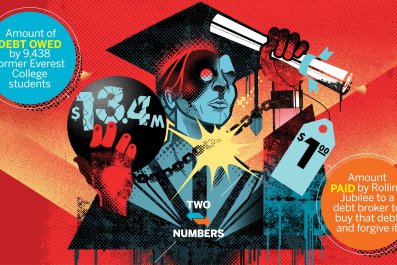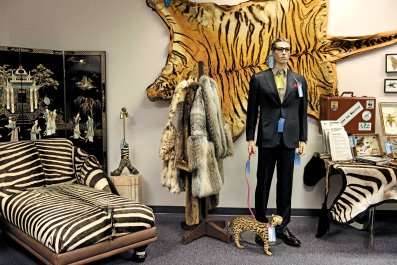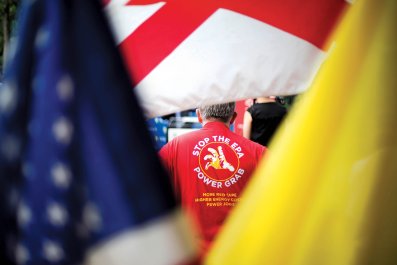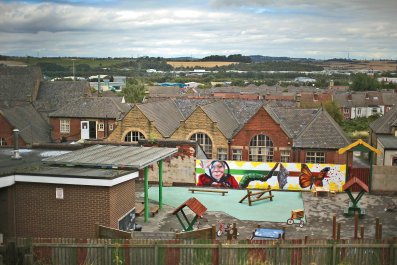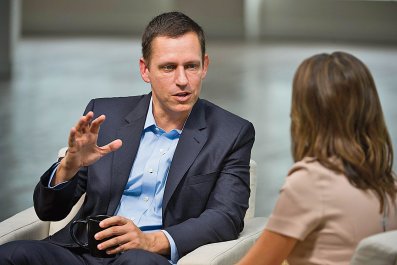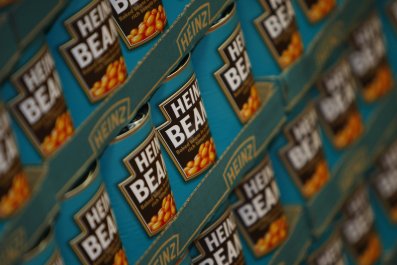In western Kenya, Mikkel Vestergaard Frandsen is sometimes treated like a demigod.
When I accompany him on his visit to local schools, we are barely out of the SUV when we are swarmed by children in sort-of-matching uniforms, singing and dancing. Everywhere we go, people—kids and adults—spontaneously break into a chant: "Asante, LifeStraw, asante!" ("Thank you, LifeStraw, thank you!") At the Emusanda Health Centre in Lurambi—built with Vestergaard funding—teary-eyed man expressed the community's gratitude, telling Vestergaard (he doesn't use the Frandsen part of his last name) that "there are babies being born named after you."
A few days later, after a treacherous, two-hour wooden longboat journey through the islands of Lake Victoria, I start to understand why.
To get to Maduwa Primary School, you have to pick your way from the shoreline of Victoria—the largest lake on the African continent—through miles of shallow channels cut out of stands of papyrus, massive patches of water hyacinth and other plant life. The Kenyan shoreline of the lake is as indefinite as cheesecloth, with streams fracturing the land into hundreds of islands, small and large. The curves through these waterways are tight and progress is slow; we often find ourselves stuck in one or another shore bank, pushing off with oars or reeds we've wrested out of the muddy lake bottom. Finally, the boat docks at the school island, a flat, grassy expanse occupied by a couple of grazing cows and, at one end, a few concrete schoolrooms arranged around a dusty courtyard.

Maduwa services about 60 children from nearby island villages, and was the most improved primary school in Kenya's Bunyala school district region last year, but it still struggles. Supplies are limited to chalkboards, tattered notebooks and pencil nubs; a dozen students cram around a desk for four, and it's hard attracting talented teachers to such a remote area. And the students are likely to be the first literate generation in their families.
But the biggest challenge Maduwa faces is the poor health of the students. If a child is sick, he or she must be taken by boat to the mainland—hours away when the lake is traversable; impossible if it's past 3 in the afternoon and the waves have begun their daily churn. The remoteness of the school means that when a child is ill, he or she could end up missing weeks or even months of class. "There are no health services here," Maduwa's principal says. "We live by the grace of God."
I had come with a team of Kenyan health workers hired by Mikkel's firm, Vestergaard, a decades-old textile company now based in Switzerland, to alleviate some of God's burden. As I speak to the principal, the team unloads the LifeStraw Community water-filtration device they're giving to the school. In lab conditions, each simple, blue plastic device can purify 70,000 to 100,000 liters of water before it needs replacing—enough, the company says, to last a school the size of Maduwa several years.
Of all the threats and challenges faced by a child being raised in a poor part of a developing country, none is more pervasive, and more basic, than unclean water. In the United States and in most of the Western world, you simply turn a tap and out pours an unlimited supply of the stuff. But in sub-Saharan Africa, 36 percent of the people (about 355 million) still do not have access to drinkable water, according to the most recent UNICEF/World Health Organization (WHO) data, and the downstream consequences are grim: 80 percent of illnesses in developing countries are linked to poor water and sanitation conditions, and the WHO estimates that 3.4 million people die from water-related diseases every year. Lack of access to safe water is particularly catastrophic for children: Globally, 20 percent of deaths under the age of 5 are due to water-related disease, and 2.5 million kids miss class each day because of these illnesses.
The team shows the students how the LifeStraw can turn muddy, brown river water into crystal-clear, safe drinking water. The team members go through use and maintenance, but before they do, they ask the kids if they've ever had a water-related illness. Hands shoot up, and the students go through the lethal list: cholera, typhoid, diarrhea, intestinal worms, dysentery, malaria, dengue, yellow fever. The team leader, Daniel Okombe Olubero, turns to me and says, "It's amazing that kids this age can name so many infectious diseases."
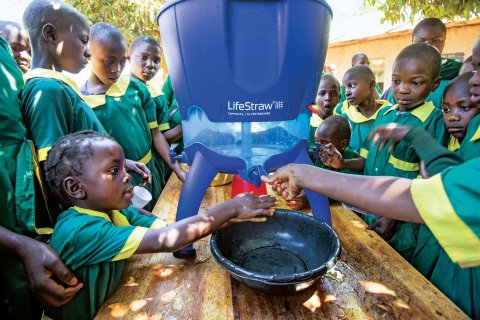
The Maduwa students, many of whom have never been to the mainland, are wide-eyed and eager to please their guests. The adults, too, flatter to the point of some discomfort: After we've been at Maduwa for longer than expected, thanks to hours of appreciative pomp and circumstance, Olubero has to awkwardly cut off the vice principal 15 minutes into his goodbye speech. Because of the afternoon waves, if we aren't out of here soon, we will have to spend the night.
A World-Changing Idea
Later that week, sitting on a hotel veranda with a beer to his right and a cup of coffee to his left, Vestergaard brushes off questions of worship. He's never noticed it, he says, and perhaps all I'm seeing is "a verification that we are picking the right schools [to visit]. There is so little attention from others."
The CEO of his namesake company, Vestergaard is a tall, globe-trotting Dane with the wire-frame glasses and the bearing of a prestige architect. He is constantly either just arriving or on his way somewhere else—most of our conversations are punctuated by sidebars with employees about his travel arrangements.
It started in his teens. Vestergaard dropped out of college and, with his parents' blessing, hitchhiked down Europe toward the Mediterranean. He jumped continents to Egypt for six months before moving on to a stint on a kibbutz in Israel. From there, he landed in Nigeria, where, at 19, he started his first business: importing car engine parts. He had no idea how to run an import business, so he would sell the parts right off the dock, before he had to deal with customs. The business boomed, but only for short while: A year later, a military coup convinced him it was time to leave the country.
When he was back in Denmark, his father asked him to join the family business, a small textile company that primarily manufactured the standard-issue uniforms given to hotel maids and catering company servers. "I couldn't imagine growing old selling uniforms," says Vestergaard, so he asked his father for the leeway to try to develop a new market: Africa.
Within a few years, the company was profitably selling blankets and textiles to African governments and aid groups for use in refugee camps and other emergency situations. Vestergaard had stumbled upon a striking discovery: He could improve people's chances in the world and make money doing it. Back home, he focused on product innovation. A mosquito net imbued with long-lasting insecticides called the "PermaNet" was recommended for use in malaria prevention by the WHO in 2004. Within a few years, it was in over 200 countries. The PermaNet and other insecticide-treated nets are widely thought to have cut global malaria deaths by about 50 percent from 2000 to 2014.

In 2005, Vestergaard scored again with the invention of the LifeStraw, a thick plastic straw that weighs two ounces and can strain out over 99.9 percent of bacteria and other parasites from 264 gallons of water. In 2005, Esquire named it the "Innovation of the Year," and in 2008, it won a prestigious Saatchi & Saatchi Award for "World Changing Ideas." It was deployed extensively after the 2010 Haiti earthquake and Pakistan floods.
Vestergaard launched the Carbon for Water project in 2008 to funnel money from large corporations toward the purchase of family-size versions of the LifeStraw filter. It's based on the idea that in rural parts of the developing world, families gather water from ground sources—streams, lakes, boreholes—and then boil it over wood fires to kill bacteria. The process emits greenhouse gases like carbon, which are terrible for the planet but valuable as a commodity if you can figure out a way to eliminate them—and quantify exactly how much you've removed.
Working with the Gold Standard Foundation, an internationally recognized carbon credit accreditation organization, Vestergaard determined how much pollution they could eliminate with each family-size LifeStraw device. Once they did the math, they were able to sell carbon credits to big corporations like Land Rover and use that money to hand LifeStraw water filters to almost a million Kenyan homes. It seems like a win-win-win: The companies improve their corporate responsibility, Vestergaard makes money, and many, many families who did not have access to safe drinking water now do so, at no cost to them. But it's still hard to believe that there's no one here who's bound to lose.
A Development Prostitute
It may feel disconcerting to read about a for-profit company not just deeply entrenched in a part of the world where the gross domestic product per capita is just $995 (compared with over $53,000 in the U.S., or $80,477 in Vestergaard's home base of Switzerland) but also making a profit. And Vestergaard has its critics. In an article for the Stanford Social Innovation Review, Dr. Kevin Starr, managing director of the Mulago Foundation, argued that Carbon for Water's emissions reduction projections were based on shoddy data, and that there wasn't any evidence LifeStraw filters work.

"Projects like Carbon for Water make a mockery of the effort to prevent carbon emissions," Starr wrote, "and as a physician, it's especially depressing to see a loopy funding scheme paired with a lousy public health solution."
Starr's criticism triggered a spirited back-and-forth: Paul van Beers of FairWater.org and Nick Moon of KickStart International also found fault with the Carbon for Water project, while Adrien Rimmer of Gold Standard and Francis Odhiambo, Kenya's Western Province deputy provincial public health officer, came to Vestergaard's defense.
Vestergaard took the criticism in stride, investing in an external advisory board, as well as additional audits and follow-ups. However, the program took a big hit in recent years as the carbon credit market has tumbled, from over $30 per metric ton of CO2 in 2008 to just $6 in 2013.
Larry Sthreshley, the IMA World Health's country director for the Democratic Republic of Congo, has worked with Vestergaard for many years. He says what happened with the carbon project exemplifies both the virtues and disadvantages of the company. "They didn't wait for a grant," he says. "Most NGOs would wait until a donor was convinced. They just looked for the funding and went out and did it with the risk that they might lose their shirt on it." Vestergaard has said his company invested $30 million in the project; it is unclear whether it recouped the money.
Vestergaard is trying other funding models. Constant innovation, he says, is what sets his for-profit company apart in the developing world. A phrase he uses often is "donors can't keep throwing new money at old problems." Many have argued that the traditional means of funding aid work and development projects—relying on donors—has become staid or, worse, potentially counterproductive and even dangerous.
Suppose, says Pranab Bardhan, an economist at the University of California, Berkeley, the purpose of your nongovernmental organization (NGO) is to reduce poverty in a region of a particular country. If you succeed, your donors will likely be thrilled—and then cut your funding. This is not to say NGOs are purposely tanking, but Bardhan says there is a risk of developing an incentive to maintain the status quo. "In conferences where there are statistical discussions of whether poverty has gone down," he says. "I have seen people acting as though they have a vested interest in showing poverty has not gone down."
Donor funds flow when the public eye is on an issue (think of the pink for breast cancer movement) but can run dry when the camera is off—as it usually is in the developing world. As a result, "you can very easily become a sort of development prostitute," says Martin Fisher, CEO of KickStart International. There are, he says, "organizations that will take money for anything," even if they have no expertise in the matter.
Misappropriated funding got so bad that "in the 1980s, we were going backwards—people were literally getting poorer," says Ben Jackson, chief executive of Bond, in London, which provides support for groups working in international development. After years of criticism, he says, "extraordinary progress" has been made. But, he adds, "there is always more we can do and should do to up our game around transparency and accountability."
On the other hand, Vestergaard has no choice but to be a model citizen when it comes to finances—and in showing results. "We are easily exposed in the private sector," he says. "We need to be very transparent about what we're doing."
(RED)undant?
The company's latest effort is Follow the Liters: For every LifeStraw product bought at retail distributors like REI or Dick's Sporting Goods, Vestergaard provides safe drinking water to "one schoolchild for one school year." In October 2014, the program brought water filters to the island school of Maduwa—and 300 other schools in rural Kenya.
The strategy, so far, is a success; the company reports selling over 750,000 retail versions of the LifeStraw product in the past fiscal year, which led to the installation of 1,639 LifeStraw Community purifiers. The sales will also support the cost of health education at every LifeStraw school, as well as monitoring and maintenance for the next five years.
Follow the Liters is the latest flavor of a trend where "consumers are taking the role that NGOs usually take in financing development projects," says Vestergaard. You've probably seen it at your local mall: For every X sold, Your Favorite Brand will give Y dollars to charity. One of the most pervasive manifestations is (RED), the tag slapped on products ranging from shower curtains to iPhone cases and used to channel millions of dollars "from the private sector to fight AIDS," according to the nonprofit organization's website.
Vestergaard is careful to set his company's work apart from (RED), pointing out that most consumers are going to have a hard time connecting a pair of sunglasses to an orphanage in Zambia. Much more sustainable, he says, is a program like his that directly connects the consumer (in this case, by purchasing a LifeStraw) to the development project (the delivery of LifeStraws to Kenyan primary schools).
There are some skeptics. The program, says Starr, "is limited by LifeStraw sales in rich countries and as such is not a bad thing. It's just not a real solution at any kind of scale."
An Intolerable Gap
The sun is setting over the cloud forests of Kakamega, the third largest city in Kenya and Vestergaard's local base. Out on the golf course of the three-star hotel, caterers are setting up the massive white canvas tent that will house a big Vestergaard party tonight. This is in keeping with Vestergaard's gap-year-meets-Silicon-Valley vibe—it is very much a work hard, play hard company.
"For me it was never about do good or save the world or anything like that," he says, popping his fifth piece of nicotine gum of the afternoon. "It also wasn't about getting rich. The underlying theme for pretty much everything I've done has been adventure." Later, the liquor will flow and the tent will be filled with smoke and laser lights and dancing bodies—including Vestergaard's—until the early morning.
But his work is dead serious. "They could have very easily gone after the American camping market first and made more money" with LifeStraw, says Sthreshley, "but instead they went for the needs of the developing world. I think it's admirable."
Vestergaard's biggest hope is that his company can prove that development work can be profitable; that other innovators in the private sector will take up the mantle; and that young talent will be drawn to the developing world instead of to Silicon Valley. He reminds me over and over that the average life expectancy is 80 years in the richest countries and 40 years in the poorest. (According to the World Health Organization, it's actually 84 and 46.) "That is an intolerable gap," he says, "but also represents a lot of opportunities for companies to come in and really make a big difference."






